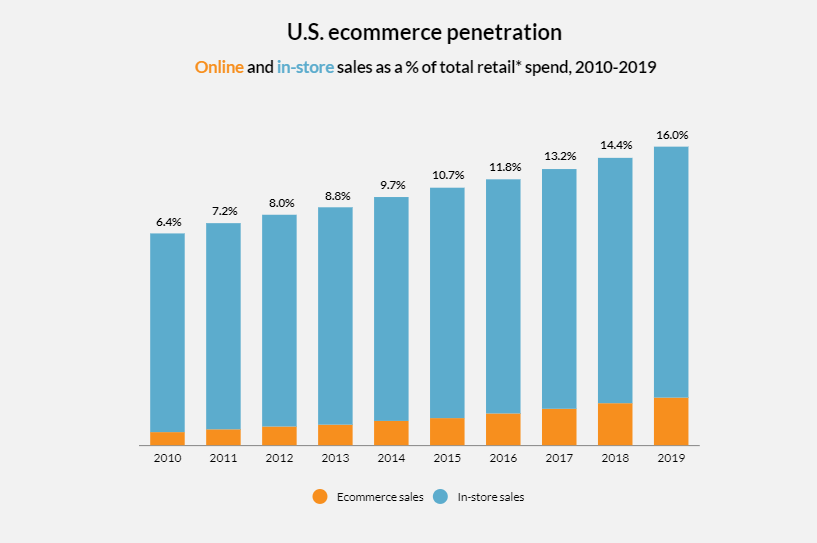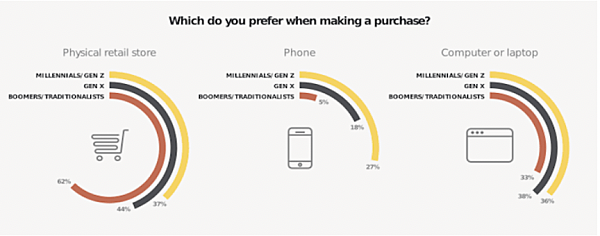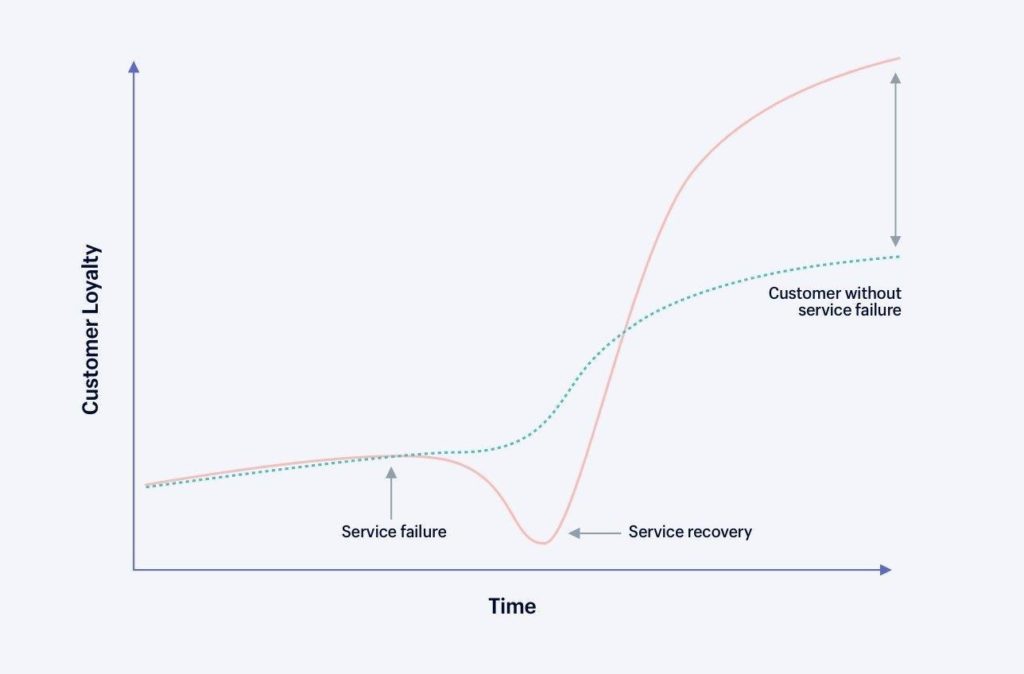Many traditional stores were already struggling as online shopping emerged as a new way to get goods. This shift picked up pace at the start of the COVID-19 pandemic as stores were forced to close, some for months on end, to stop the spread of the disease. However, the high street is not dead yet!
As brands adapted to the COVID-19 situation, many expanded their brick and mortar offering to include an online presence. Offering both options is a great way for a brand to provide the best customer experience. The fact that Amazon, the world’s largest e-commerce company, is also investing in physical stores shows the importance of a storefront.
Click to Jump
Why Brick-and-Mortar with Ecommerce Is A Good Combination
The online boom and now the pandemic have led to a greater adoption of online shopping. This is why online store owners are spending heavily to come up with new algorithms and bots that act as surrogate salespeople, giving recommendations and advice.
You already understand the many benefits of a physical store. But combining brick-and-mortar with an online store built with powerful ecommerce platform gives a business the competitive edge against a physical-only brand. Especially in these times, you should really invest in expanding your online presence to boost your brick-and-mortar business.
An online store allows you to showcase your products to a wider audience, including those who cannot visit you in person, whether due to lockdown restrictions or geographical distance. Reaching your customers online through social media and email marketing also builds brand recognition. If a regular customer sees your social media post or receives an email from your company, they’ll likely recall their last visit to your physical location.
Online sales made up about 16% of all sales in the US in 2019. This year, it is safe to assume the figure will be even higher:

Source: Digital Commerce 360
Since total spend is also growing year-on-year, you cannot afford to neglect either side if you want to reach your business goals.
Speed Up Buying Process
Shopping online allows the customer to bypass lines at the checkout and speed up the buying process. The time between placing products in the basket and paying for them can be reduced considerably as a cashier does not need to scan each item individually. And that’s before we consider the time the customer saves from shopping in the comfort of their own home. For the time-strapped consumer, this is one of the biggest advantages of shopping online.
Combining brick and mortar with an online store also lets customers learn more about products online before they visit your physical store. This cuts down on browsing time. Many customers will browse an online store before visiting a physical location already knowing exactly what they want.
Better Marketing Opportunities
In-store marketing campaigns can suffer from one glaring drawback: proximity to the consumer. For a brand to market itself successfully, it needs to use multiple channels to reach consumers. This is where an online presence helps you reach out to consumers through channels like social media, your website, email marketing.
Online marketing brings your brand to the place closest to your customers: their devices. The internet allows your campaign to attract far more attention and reach a wider customer base.
Another benefit of the combination of brick and mortar with an online store is that it gives you another way to collect customer data for marketing purposes through a customer data platform. For example, why not collect email addresses from people visiting you in-store in exchange for a small discount or special offer? This will help you grow your email list and keep reaching those customers long after they’ve left your shop.
Pro tip: use an online email verifier tool to ensure the validity of your data. Sites like Voila Norbert, Find Emails, and ContactOut can help with this. Verifying the addresses before adding a customer to your list will keep your bounce rate low and deliverability score high.
Better Customer Engagement For All The Generations
Different customers like to shop differently. While the younger, tech-savvy generation tends to prefer buying products online, older customers may prefer to visit a physical store (of course there are exceptions to both of these generalizations)!
When you combine brick and mortar with an online store, you can cater to all shopping habits and preferences. This gives you a wider reach and therefore a broader potential customer base.
When you offer different shopping channels, you can customize both the shopping and marketing experience to customers’ preferences. It also allows for hybrid options like click-and-collect or “buy now, delivery later” models. In short, the more options you have to customize the shopping experience, the more satisfied customers you’ll have.
A study by Salesfore, a leading customer service software company, showed that people born pre-1990 tend to prefer a physical store, while Millennials and Gen Z are comfortable with online buying. The study also noted that 57% of the older generation preferred to visit a physical store for any post-purchase service requirements. The younger generation, however, was split between phone, online, and physical store-based service options, with only 32% preferring to visit a store.

Source: Salesforce
Personalized Experience
Despite the rise of ecommerce, there is still one area where the physical store reigns: personalization. An app or ecommerce system will never be able to match the customer experience of another person guiding you through the products. By combining the two cornerstones of great customer experience – personalization and convenience – the combination of brick and mortar with an online store is a winning formula.
One of the reasons people choose one store over another is familiarity. People tend to prefer names they know and trust. Having a physical store gives you more scope to build that familiarity and trust.
You can somewhat replicate the personalization and familiarity of a physical store with a few online marketing tricks. Segment your email list by relevant demographics or interests to ensure customers receive only the most relevant communications. Then you can personalize everything from the sales email subject line to the offers your customers receive.
Taking Your Brand Online
With so many benefits, it is no surprise that many brands with physical stores are adding an ecommerce store to their business model. Let’s start by looking at taking your brand online. There are several key steps to this process.
Understanding your audience
Understanding your target audience will set the stage for all other decisions you’ll make. Before you do anything else, you’ll need to understand who you are trying to reach. Your online customer base is likely to be similar to that of your brick-and-mortar store, but you might aim to reach a slightly different or broader section of the market.
If you have not yet created a customer persona, do so now. This is a profile of your ideal buyer and includes demographic information, goals, needs, and pain points. Here’s an example:

(Source)
You should have separate customer personas for your online and physical stores.
Figure out the scope and policies of your online store
What will you sell online? Some brands put their entire inventory into their online store, while others offer just a small selection of popular items. I recommend including as broad a selection of your products as possible to appeal to the widest possible audience. If you prefer, you can start with just your core products and then add to the online catalogue later.
Don’t forget you’ll need professional product photographs – smartphone snaps won’t cut it.
You’ll also need to figure out site policies and procedures. For example, will you ship worldwide or only within your home country? Will you allow returns or refunds? Will you offer free shipping over a certain order amount? And so on.
Build your site
If you already have a website, you can add your online store to that site. If not, you’ll need a new website. You can do this yourself, or employ a web designer or agency to help you. If you have the budget, hiring a professional with experience in ecommerce is best. If you’re doing it yourself to build a website, a platform like WordPress or Squarespace makes the process easy and doesn’t require you to learn how to code.
Don’t forget to budget for your domain name and website hosting. You don’t want to go for the cheapest option, here – instead, do your research and choose a reliable hosting company. If you can afford it, dedicated or cloud hosting is better than shared hosting. When it comes to website hosting, VPS hosting is a popular option that offers more control and flexibility compared to shared hosting.
Your site’s domain name should be short, memorable, and easy to spell. Ideally, it should relate directly to the name of your physical store.
The best way to build a great online store is to use a reliable ecommerce platform that you can integrate into your website and other systems you use. Shopify, 3dcart, and WooCommerce are three great choices when it comes to ecommerce platforms, and offer a range of packages to suit different budgets. They also allow you to enable a range of payment options such as credit and debit card, Apple Pay, and Paypal.
I cannot overstate the importance of fantastic site copy and product descriptions. If you want your site to succeed, these must be well written and optimized with conversions in mind. Here are a couple of my quick top tips for amazing product copy:
- Focus on benefits, not features. In other words, what will customers get out of purchasing and using your products?
- Use short sentences, bullet points, and plenty of white space. In other words, keep it concise.
- People skim read, so include the most important information in the first three sentences.
- Run everything through a Grammar checker like Grammarly.
You can always employ a professional copywriter to do this for you, if you wish. They know how to get the message across in the best possible way.
Excellent Customer Experience With Brick-and-Mortar & Online Store In Three Stages Of the Buying Process
The real work begins after your online store is live. There are three main stages of buying: pre-purchase, during the purchase, and after purchase. In each stage, you will need to undertake various steps to provide the best customer experience.
Let’s look at each in turn.
Pre-Purchase
The internet is a vast space with a seemingly endless array of content, making it difficult to give your brand the visibility it needs. In amongst viral content and targeted advertising by big-pocketed companies, it is easy to get lost. This is where your marketing efforts kick in.
Are you reaching your target audience? First, make sure you’re on the right platform(s). Social media platforms allow you to reach many people at once, but you’ll only see success if you go where your target audience is. For example, if your brand targets young people and college students, Instagram is your best bet. If you want to reach older professionals, LinkedIn is a more appropriate choice.
You must also invest in email marketing. You can encourage people to sign up for your mailing list via a lead magnet, which is a freebie you give away in exchange for their email address.
Finally, put some effort into helping your site rank in searches on Google and other search engines. Good search engine optimization (SEO) practices encourage organic growth and help you reach the right kind of consumers. Great SEO means targeting the right keywords and sharing regular, high-quality content that is optimized for those terms.
During The Purchase
The customer is ready to browse your store and buy, but is your website ready? People who buy online use an array of payment methods ranging from their credit card to online wallets and Paypal. Your website should be set up to support as many options as possible
This is where your web design kicks in. Are your top products easy to find? Are your inventory items categorized appropriately? Website design and ease of use sets the stage for the purchase. The ease with which customers are able to “walk” through your online store will determine the purchases they make (and whether they come back again)!
As mobile technology becomes ever more ubiquitous, smart brands are taking a mobile-first approach to web design. Around 50% of traffic globally now comes from mobile devices, so make sure your site is responsive to all screen sizes.
After-Purchase Services
Many businesses make the mistake of thinking that the customer experience ends after the purchase is made. However, your after-purchase services, such as customer support and refund policies, are essential components of your ability to retain customers. If you want to reduce churn and have people return again and again, make sure that you dedicate the resources to providing stellar customer support.
When a customer buys from a physical store, they know where to come back to if something goes wrong. This can be less clear with an online store and this can be a deterrent, especially for products that carry a higher price tag. Having a solid after-sales program in place, and displaying it prominently on your ecommerce website, gives your customers the confidence they need to trust you.
Did you know that experts believe resolving an issue professionally actually has a greater impact on customer loyalty than if the problem had never happened in the first place. This is known as the service recovery paradox, a term first coined by Sundar Bharadwaj and Micheal McCollough:

Source: Shopify blog
Obviously I don’t mean to suggest you should create problems just to solve them! But if something does go wrong, resolving it professionally can actually improve that customer’s experience in the long run.
Bottom line
A combination of brick and mortar with an online store is cross-channel selling at its best. It allows you to cater to people across age groups, demographics, and purchasing preferences by pulling in the best elements of both business models. In this increasingly digital economy, both the consumer and the seller stand to gain from the combined approach to commerce.
Online shopping is on the rise and here to stay. However, a physical store owner need not not see this as a threat to their survival. Instead, they should see it as an opportunity to add value to their brand and attract new customers. An omnichannel that combines both is a win-win for all parties and will no doubt become increasingly normalized.
[hr]Owen Baker is a content marketer for Voila Norbert, an online email verification tool. He has spent most of the last decade working online for a range of marketing companies. When he’s not busy writing, you can find him in the kitchen mastering new dishes.
If you’re interested in boosting your word-of-mouth marketing strategy, check out ReferralCandy and InfluencerCandy!


